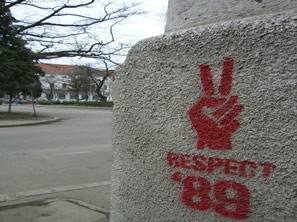Three Romanian Postcards
Ania SPYRA, originally from Poland, is a PhD student in English at the University of Iowa. Her dissertation, Cosmopoetics: Multilingual Experiments in Transnational Literature, examines issues of cosmopolitanism and linguistic mixing in twentieth-century transnational, multilingual literature of Europe and the Americas. In the spring of 2006 she taught literary criticism in the Creative Writing Program at the University of the West in Timisoara, Romania.

Martisor
Whether in memory of some ancient fertility rites, or because of the International Women's Day on the eight of the month, March is considered women's month in Romania.
At the end of February, the central square of Timisoara, Piata Victoriei, filled up with artisans selling their Martisor trinkets: brooches and pins, cardboard cards and paper flowers, all with a red and white string attached to them. On March 1, also known as Martisor (a diminutive for the name of the month in Romanian), men give these to the women in their lives. Supposedly they can even offer those to someone in the street. Women, in turn, wear these for the rest of the month, or at least till the eight, as a symbol of spring. They usually cut off the cardboard or the paper and wear the string itself on their wrists wrapped around a button or a watch, or pinned with a brooch. I have been paying attention to my colleagues at the university and they really do wear their Martisor strings. I wore mine only on March 1: my husband insisted, since he bought me a martisor already on Valentine's Day. When I had asked him what it was, he said he was hoping I was the one who would know; we only figured it out two weeks later.
Of course, to my feminist mind, there are overtones of tagging in this whole ritual: strings always attached.
Beep-beep-beep Poverty Haunts
Rob, the American professor, was walking me back home after we had dinner with our Romanian university liaison at Bohema, a restaurant with white linen tablecloths and a waiter in a bowtie who holds his left arm behind his back when he pours your fizzy water into the wine-glass. We were on the main square of Timisoara, Piata Victoriei, when the teenage Gypsy girl with long braided hair approached us, hand outstretched; she tugged at my sleeve and repeated ‘dai, dai’ in a scratchy whisper. Haunting, it sounded like ‘die’ in English, and – as in Romanian, although spelled differently – it also means ‘give’ in my native Polish. I had no change, just the big plastic bills. Rob pulled out a coin, handed it to the girl and she stopped to inspect it.
Rob and I talked in our outstanding language for a little while longer, said our goodnights and I was at my front gate – that is, the ugly metal door that you have to open by punching in a code to get to the pretty Mediterranean courtyard with a wrought iron-and-marble staircase that leads to my apartment. Suddenly there was another girl by my side, a shorter, younger one with her disheveled hair inexpertly cropped repeating ‘daj, daj’ as if she knew I was Polish, as if she knew it was just the language in which to get through to me. I started pressing the code: two digits, a symbol, four more digits, but I got it wrong. I started again, and this time the girl focused her attention not on me but on my fingers pressing that code: beep beep beep. Will she learn it by heart?
“Hey,” I said and she looked at me with her big big eyes; her older companion joined in and stared at me as my fingers completed the code – beep beep beep beep. The door buzzed, I walked in and pushed it locked behind me. The Green Zone.
For a second I felt relieved but as I took my first step I heard the beeping begin. Beep beep beep. Did they remember the code? What is the statistical chance that they will get it right? Will they follow me in? I skipped up the antique stairs; beep beep beep. Third floor, my door: the one to the shared hallway, with two locks. The beeping echoed in the courtyard while my keys clanked. I locked the door behind me. The second door, to my place; I locked that too.. A look down into the courtyard; I drew the curtains. Calm. No beep beep anymore. I can hear no dai, daj, die.
Traces of the Revolution
Walking around Timisoara, you sometimes come across façades still pockmarked by machinegun fire. Piata Victoriei is an obvious place immortalized on the 1989 photographs. Bullet scars in the old buildings with stripping paint do not surprise you: they are to remind you of the anti-Ceausescu revolution that started here.
But when you are away from the city center you may come across the bullet holes in quite unexpected places. In a quiet villa neighborhood, houses painted green or ocher, potted plants in the windows, you suddenly see what looks like a grave: a tombstone leans over a fence and a face of a young boy in black-rimmed glasses looks past you into the future from one of those ghostly funerary pictures. If you can read some Romanian, you will learn that it is a memorial to an eighteen year old shot on that very spot on December 23, 1989. Only then, you look around to see that he was not shot with a pistol. The machinegun fire left traces on the villas around.
Or you're walking in a wide street with tall communist blocks, you look up because an enormous billboard enlivens the grayness of the landscape, and there, by the twentieth-story window you see a whole sieve of bullet holes. You wonder and look around again, seeking to trace the story. When you see the police station right across, a storyline appears, like a Hollywood script; the puzzle becomes more solvable. You imagine a sniper sitting on the roof of that building, shooting across at the police, who respond with a Kalashnikov salute.
Revolutions adore logos. Each has a trademark: the Odpor fist in anti-Milosevic Serbia, the bloody red Solidarnosc with the Polish flag waving from the ‘n,' and here the hand with the index and middle fingers in a V – the victory sign (or peace?) subtitled “RESPECT 1989”. The bloodiest anti-communist revolution in Europe and the peace sign? I am not sure if it had the same function before the revolution as the other symbols did; if it was painted over Ceausescu's portraits and the communist party's election posters, or if it was only designed after the victory, when the respect was already won. On the walls of Timisoara, it acts as another trace of the revolution.
But the slogan seems so apt: isn't respect what revolutions are for?



